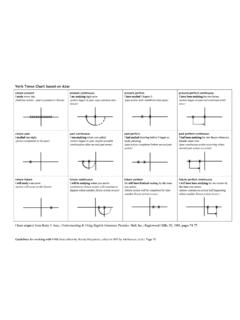Transcription of READING LITERARY (RL) READING ... - Georgia Standards
1 Kindergarten English Language Arts Georgia Standards of Excellence (ELA GSE) Georgia Department of Education April 15, 2015 Page 1 of 6 READING LITERARY (RL) READING INFORMATIONAL (RI) Key Ideas and Details Key Ideas and Details ELAGSEKRL1: With prompting and support, ask and answer questions about key details in a text. ELAGSEKRI1: With prompting and support, ask and answer questions about key details in a text. ELAGSEKRL2: With prompting and support, retell familiar stories, including key details. ELAGSEKRI2: With prompting and support, identify the main topic (main idea) and retell key details of a text (supporting details).
2 ELAGSEKRL3: With prompting and support, identify characters, settings, and major events in a story. ELAGSEKRI3: With prompting and support, describe the connection between two individuals, events, ideas, or pieces of information in a text. Craft and Structure Craft and Structure ELAGSEKRL4: With prompting and support, ask and answer questions about unknown words in a text. ELAGSEKRI4: With prompting and support, ask and answer questions about unknown words in a text. ELAGSEKRL5: Recognize common types of texts ( , storybooks, poems). ELAGSEKRI5: Identify the front cover, back cover, and title page of a book.
3 ELAGSEKRL6: With prompting and support, name the author and illustrator of a story and define the role of each in telling the story. ELAGSEKRI6: Name the author and illustrator of a text and define the role of each in presenting the ideas or information in a text. Integration of Knowledge and Ideas Integration of Knowledge and Ideas ELAGSEKRL7: With prompting and support, describe the relationship between illustrations and the story (how illustrations support the text). ELAGSEKRI7: With prompting and support, describe the relationship between illustrations and the text (how the illustrations support the text).
4 ELAGSEKRL8: (Not applicable to literature) ELAGSEKRI8: With prompting and support, identify the reasons an author gives to support points in a text. ELAGSEKRL9: With prompting and support, compare and contrast the adventures and experiences of characters in familiar stories. ELAGSEKRI9: With prompting and support, identify basic similarities in and differences between two texts on the same topic ( , in illustrations, descriptions, or procedures). Range of READING and Level of Text Complexity Range of READING and Level of Text Complexity ELAGSEKRL10: Actively engage in group READING activities with purpose and understanding.
5 ELAGSEKRI10: Actively engage in group READING of informational text with purpose and understanding. Kindergarten English Language Arts Georgia Standards of Excellence (ELA GSE) Georgia Department of Education April 15, 2015 Page 2 of 6 Print Concepts READING FOUNDATIONAL (RF) ELAGSEKRF1: Demonstrate understanding of the organization and basic features of print. a. Follow words from left to right, top to bottom, and page-by-page. b. Recognize that spoken words are represented in written language by specific sequences of letters. c. Understand that words are separated by spaces in print. d.
6 Recognize and name all upper- and lowercase letters of the alphabet. Phonological Awareness ELAGSEKRF2: Demonstrate understanding of spoken words, syllables, and sounds (phonemes). a. Recognize and produce rhyming words. b. Count, pronounce, blend, and segment syllables in spoken words. c. Blend and segment onsets and rimes of single-syllable spoken words. d. Isolate and pronounce the initial, medial vowel, and final sounds (phonemes) in three-phoneme (consonant-vowel-consonant, or CVC) words. (This does not include CVCs ending with /l/, /r/, or /x/.) e. Add or substitute individual sounds (phonemes) in simple, one-syllable words to make new words.
7 Phonics and Word Recognition ELAGSEKRF3: Know and apply grade-level phonics and word analysis skills in decoding words. a. Demonstrate basic knowledge of one-to-one letter-sound correspondences by producing the primary or many of most frequent sounds for each consonant. b. Associate the long and short sounds with the common spellings (graphemes) for the five major vowels. d. Distinguish between similarly spelled words by identifying the sounds of the letters that differ. Fluency ELAGSEKRF4: Read common high-frequency words by sight. ( , the, of, to, you, she, my, is, are, do, does); read emergent-reader texts with purpose and understanding.
8 Kindergarten English Language Arts Georgia Standards of Excellence (ELA GSE) Georgia Department of Education April 15, 2015 Page 3 of 6 Text Types and Purposes WRITING (W) ELAGSEKW1: Use a combination of drawing, dictating, and writing to compose opinion pieces in which they tell a reader the topic or the name of the book they are writing about and state an opinion or preference about the topic or book ( , My favorite book ). ELAGSEKW2: Use a combination of drawing, dictating, and writing to compose informative/explanatory texts in which they name what they are writing about and supply some information about the topic.
9 ELAGSEKW3: Use a combination of drawing, dictating, and writing to narrate a single event or several loosely linked events, tell about the events in the order in which they occurred, and provide a reaction to what happened. Production and Distribution of Writing ELAGSEKW4: (Begins in grade 3) ELAGSEKW5: With guidance and support from adults, respond to questions and suggestions from peers and add details to strengthen writing as needed. ELAGSEKW6: With guidance and support from adults, use a variety of tools to produce and publish writing, including digital tools in collaboration with peers. Research to Build and Present Knowledge ELAGSEKW7: With guidance and support, participate in shared research and writing projects ( , explore a number of books by a favorite author and express opinions about them).
10 ELAGSEKW8: With guidance and support from adults, recall information from experiences or gather information from provided sources to answer a question. ELAGSEKW9: (Begins in grade 4) Range of Writing ELAGSEKW10: (Begins in grade 3) Kindergarten English Language Arts Georgia Standards of Excellence (ELA GSE) Georgia Department of Education April 15, 2015 Page 4 of 6 Comprehension and Collaboration SPEAKING AND LISTENING (SL) ELAGSEKSL1: Participate in collaborative conversations with diverse partners about kindergarten topics and texts with peers and adults in small and larger groups. a.












